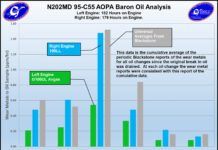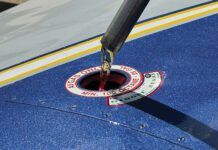
by Jim Cavanagh
Aircraft owners have been waiting for 25 years for the next great fuel that would replace the deadly, lead-bearing avgas that the entire industry-at least on the piston side-depends on. And for just as long, the aviation press has been publishing sky-is-falling stories about the imminent demise of 100LL.
Hasnt happened. Why? While leaded avgas does represent a potential problem, it doesnt have to do with availability so much as not knowing what to expect. Pilots and the aviation press seem to be most worried about suddenly losing supplies of avgas with no replacement readily available.
But while pilots worry about avgas disappearing, we can find no one in the oil industry or government who thinks it will happen or is interested in making it happen, at least on any kind of reasonable timeline that an owner might plan for.
This may sound like a good thing but its not all good. With no impetus for a lower octane, lead-free replacement, fuel research is more stagnant than it might otherwise be and the ignition systems that would make it possible to burn lower octane fuel arent gaining much sales traction. That means if avgas suddenly does disappear, alternatives may not be ready or sufficiently tested.
What Problem?
The push to eliminate avgas owes its origins to the 1974 Safe Drinking Water Act and to EPA efforts to eliminate lead from automotive fuels before that.Discovered by a German scientist in 1854, tetra ethyl lead (TEL) sat on the lab shelf as a curiosity until 1921, when Charles Kettering found that of all of the hundreds of additives tried to boost octane and eliminate detonation in high-compression engines, TEL worked best. In the intervening 85 years, no better octane enhancer has been found.
It doesnt take much lead to eliminate fuel-induced knock. The maximum amount is 0.56 grams per liter or 2.1544 grams per gallon. Still, according to the Aerospace Forecast 2006-2061 from the FAA Office of Policy and Planning, we will use 290 million gallons of avgas in 2006. This will deposit 580,000 pounds of lead back into the atmosphere, less what gunks up engines and exhausts.
From its earliest days, the use of TEL caused scandalous environmental and health issues, especially in the refining industry, where it accounted for many deaths. By the early 1980s, EPA rules called for phasing out of TEL from motor fuels for two reasons: To allow the use of catalytic converters that clean up exhaust emissions and to eliminate the tons of lead being injected into the atmosphere from car exhausts.
Its a common misperception that the Clean Air Act gave the aviation industry a waiver to use leaded fuel. What it actually did was stay the elimination of TEL while turning the problem over the FAA, which could then determine if leaded avgas was a serious enough environmental hazard to require further regulation. Thus far, the FAA has made no such determination.
Avgas has another environmental problem in addition to lead. Another additive called ethylene dibromide is blended into avgas as a lead scavenger.Without it, your spark plugs would cease to function in a few hours. The Safe Drinking Water Act addressed EDB, setting a so-called contaminant-level goal of 0.50 parts per billion. Call that zero. The EPA did. EDB affects the stomach, liver and adrenal glands and could cause respiratory failure, damage to the nervous system, liver, kidney and heart disorders and cancer. It becomes a contaminant through spillage at refineries and during aircraft fueling.
The curious thing is that when we took the EPAs current temperature on this issue, we found no active interest in ridding avgas of TEL. EPA spokesperson Kim Olsen told us the issue still resides entirely with the FAA.That agency has hardly ignored the leaded avgas problem-if, indeed, it really is a problem-but it has taken advantage of the EPAs provision to carry on research into alternative fuels. The FAAs Dave Atwood, who works at the agencys William J. Hughes Technical Center in Atlantic City, New Jersey, told us that fuels research continues. But because avgas remains available, there’s no strong economic impetus to phase it out quickly, nor is there a detectable environmental outcry against 100LL.
When you consider the numbers, its easy to see why. The aviation industry consumes about 290 million gallons of avgas per year, while cars and trucks in the U.S. use 350 million gallons per day of auto fuel. Doing the math for you, avgas accounts for less than one percent of all motor fuel use in the U.S., making the industry the tiniest of fish in a big sea.
Comfortable Business
Two other common myths cause pilots to believe that 100LL simply has to go away sooner or later. One is that because of the aforementioned small volume, the oil companies want to phase out refining avgas in favor of more profitable products. Second, there’s only one source of TEL remaining in the world, Associated Octel/Innospec, and the company has put the refiners on notice that it will stop making TEL.
If either of these is true, no one will say as much. The avgas refiners have always said that aviation fuel is a small but profitable aspect of their business and they are still saying that. With a refining and distribution infrastructure in place, its in the best interests of the refiners to either continue producing 100LL or find a replacement that results in the fewest changes to the in-place system.
One way of doing that is to use a so-called baseline fuel that contains the fundamental chemical elements for any motor fuel, be it cars, boats or airplanes. The baseline can be pumped through pipelines without expensive product switchovers and when it reaches the appropriate terminal, market-specific additive packages can be blended in. Any truck hauling avgas now has to be dedicated to that purpose and if its not, each compartment has to be emptied and flushed before a load of unleaded motor fuel can be delivered.Sharing delivery and storage facilities with the automotive supply stream has obvious advantages. One petrochemical engineer we know told us this might reduce avgas prices by as much as 15 percent. But as long as TEL is available and allowed by the EPA/FAA, there’s not much impetus to develop a baseline fuel market.
And as for TEL, Associated Octel/Innospec continues to manufacture the product in its Ellesmere Port, England, location, in spite of environmental pressures. Some wonder what will happen if the revenues generated by TEL sales drop enough to cause Octel/Innospec to cease manufacturing, but David Turner, sales and marketing director for the company, told us that the company has every intention of producing the material as long as it is required for avgas. We can only speculate that as production and logistical costs escalate due to environmental concerns, so will the price of the additive rise. But there’s no indication that its about to disappear. While its true that fully 70 percent of the GA piston fleet can burn fuel that doesnt need TEL-enhanced octane, the great oddity is that the remaining 30 percent of the fleet-twins and high performance singles-burn 70 percent of the aviation fuel consumed in the U.S. Since the industry long ago abandoned lower octane fuels, it makes economic sense to distribute only one grade and thats TEL-spiked 100LL.

Alternatives
In the history of any technology, including aviation, economics have driven new developments. There’s no point in making what you cant sell. With that in mind, the oil companies havent stood idly by awaiting the FAA to pull the plug on avgas. Working in concert with the FAA, a number of high-octane unleaded fuels have been developed and tested.
To understand these, here are some basics about octane: All certified aviation fuel is lumped under a standard called ASTM-D910. If a fuel is not listed under that standard, it has to undergo a certification process that could take five to 10 years. In 2003, a fuel that had been previously approved was reinstated through the work of General Aviation Modifications, Inc., the EAA and others. This is called 91/98 UL, similar to another fuel called 91/96UL thats manufactured in Sweden and is used in Europe.
To decipher these numbers, 91 is the motor octane or MON octane rating and 98 is the octane available through a different test, called the supercharging method, a number thats mostly ignored for aviation use but still appears in the spec.
GAMIs Tim Roehl told us that if you removed the lead from 100LL, youd have a 92 MON fuel. It would be suitable for low-compression engines but not turbocharged engines, with their lower detonation margins. But since the demise of 80/87, no one in the industry wants to fool with two fuel grades, mainly because of the distribution and storage costs. Therein lies the problem. If there’s one new, lead-free fuel to be developed, it will have to be of sufficient octane to burn we’ll in detonation-challenged engines. Thus far, that fuel has not emerged in a production-ready version and its unclear if it will.
Unleaded fuels in the 100 MON and 104 MON range have been refined by Exxon and, using an ammonia- based anti-knock package, 91/98UL (a baseline fuel), 93 MON avgas and 95 MON avgas have been developed. However, none are certified and all have toxicity and handling issues.
A 91/98UL avgas has been approved by the FAA, however, its not in production and may not be for quite some time, if ever. This is a mid-octane aviation fuel developed in the 1990s because it was simple to produce. It uses the same base stock as unleaded auto fuel but is blended with additives suited for aircraft engines. But this grade of fuel, however attractive, might never see production because the economics don’t favor it.
Heres why: Ken McCarley, of ConocoPhillips, told us his company is working on the development of only one replacement for 100LL, a 100 MON grade, and its ignoring any lower octane fuel. The aviation community has defined this as the only acceptable fuel, he said, because it can be used by all GA aircraft. This would obviate the need for any sort of electronic ignition to adjust engine timing to tolerate lower octane, even though these systems might have other performance and durability advantages. It also assumes that the 100 MON fuels retain sufficient detonation margin in the highest compression, hottest-running engines. So why not accelerate the development of 100 MON fuel and get it out there? For the simple reason that as long as 100LL is available and not threatened, there’s simply no market for a new fuel. Yet.
Alcohol, Diesel
For awhile, it looked as though bio-based ethanol might be a player in the aviation fuel market. The University of Illinois researched ethanol as an aviation fuel in the 1980s and ethanol is currently being mixed with unleaded auto fuel for automobile use, particularly in the big ag states of Iowa, South Dakota and Wisconsin. Dennis Helder, at the University of South Dakota, told us that ethanol production today is 3 billion gallons a year, 10 times what general aviation uses in avgas. In fact, ethanol volume is high enough to make prices competitive with 100LL.
The University of South Dakota has developed a fuel they called AGE-85 or aviation grade ethanol, a mixture of 85 percent ethanol, light hydrocarbons and a bit of biodiesel made from soy. ConocoPhillips is working with AGE producers to develop the specifications required before the certification program can get started.
But there are significant shortcomings with ethanol. In its current evolution, it cant deliver the kind of energy needed for larger engines, meaning youd need to carry 10 or 20 percent more of it for the same range that 100LL delivers. An AGE-based fuel would also require an overhaul of the distribution and storage infrastructure, making its economics doubtful when compared to a petroleum-based 100LL replacement.
For the world market-which is anywhere other than the avgas-centric U.S.-Jet-A powered piston engines are the emerging trend. Diamond Aircraft has achieved remarkable success with its Thielert-powered DA40 Star and Twin Star. All told, some 900 Thielert diesels are flying, but just a few are in the U.S. SMA continues to push its four-cylinder diesel but neither Thielert nor SMA can claim anything approaching significant market penetration.Although Diamond has found diesel demand stronger than anticipated, its difficult to see Jet-A piston technology being a major player for at least five years.
Electronic Controls
One of the more promising solutions to the octane problem posed by unleaded aviation fuel is ignition systems that increase detonation margins by varying spark timing in the way that automobile engines have for decades. Two systems are at the forefront, TCMs Aerosance-developed PowerLink system and GAMIs PRISM systems.
The PowerLink system has been flying for six years and is certified-or is at least certifiable-for a number of aircraft engines. Its an automotive-style design using pulsed fuel injection and variable ignition timing and although not currently configured with knock sensing, were told that it could be. Ultimately, PowerLink could be a single-lever system, with electronic prop and turbocharger controls. It hasnt evolved to that point in a production version.
GAMIs PRISM system uses cylinder pressure sensing to adjust timing, snuffing detonation in problem engines forced to burn lower octane fuel.Using one of the most detonation challenged engines in the fleet, Lycomings TIO-540-J2BD, GAMI has proven that high-power engines can run safely on 95-octane unleaded fuel. PRISM is not certified and hasnt flown yet although as with the knock sensing capability for TCMs PowerLink, there don’t appear to be any technical showstoppers.
But there is one problem and its huge: market interest. TCM has made little market penetration with the PowerLink system. Only one OEM-Liberty Aerospace-has shown enough interest to offer it as standard equipment and there are fewer of these systems installed than Thielert has diesels flying.Buyers evidently havent seen enough benefit in PowerLink to convert older airplanes or demand it in new ones.
PRISM may suffer a similar problem. Although both it and PowerLink promise improved performance and engine management over the ancient magneto system, buyers may not perceive enough advantage to pay the installation premium, which we would guess to be in the $8000 to $10,000 range. While there’s little doubt that this technology can solve the octane problem, there’s also little doubt that it wont be given the chance as long as 100LL is still available.
Conclusion
Clearly, the aviation press crystal ball has proven defective in predicting the demise of 100LL. The stories we published 25 years ago turned out to be, quite simply, wrong. Our most recent sweep through the topic reveals that although the rest of the world is moving away from 100LL and toward Jet-A, there seems to be no discernible sentiment to do that in the U.S.

If there’s a gathering storm to eliminate 100LL, no one we talked to could point to the clouds on the horizon and say, look, there they are. Economics drive everything and thats whats happening here. Avgas producers have a stable market with an established distribution network which delivers reasonable profits. There’s no hue and cry to eliminate lead from avgas, neither from the FAA nor the EPA. There’s the assumption that it will happen but no action to make it happen.
One worrying chokepoint is the single source of TEL, Octel/Innospec. With no competition, can the company charge what it pleases? Perhaps, but the TEL additive accounts for only about 3 cents per gallon so even a doubling of TEL prices would be buried in the monthly rise and fall of prices at the pump. Of more concern is an accident at the plant or environmental regulations in the UK that might preclude further production of TEL. We can only rely on what Octel/Innospec tell us, which is business as usual.
What does it all mean? Assuming the TEL supply remains stable-and we think it will-the evolution of aviation piston fuel may be driven not by lead-spiked octane but by price alone. At some point, the price of a gallon of avgas will rise to the point that a lower-octane baseline fuel may become attractive as a lower-priced alterative or interest in Jet-A driven diesels will suddenly take off. Or both. This development may also make electronic controls more economically attractive than they have been thus far.
We have no idea what that price point is. Weve seen $8 avgas in Europe, but pilots there are still buying it, albeit in declining volume. But for the foreseeable future, leaded avgas is a long way from being extinct.
Also With This Article
“100LL Avgas Price History (Less Taxes)”
“Mogas Isnt the Answer”
-Jim Cavanagh is a freelance aviation writer. He lives in Kingsville, Missouri.




